Space has power. Why? The spaces around us are imbued with energy.
Have you ever walked into a room of people, for instance, and felt the overall ‘vibe’ to be heavy, awkward, or suffocating? In contrast, you might walk into a temple or religious chapel and feel the very air vibrate with hope, praise, and reverence.
Intuitively we sense that everything is energy, and everything vibrates at a certain frequency.

Spiritual Wanderer Course:
Being a lone wolf and a spiritual wanderer is a sacred calling in life – a unique and alchemical path of awakening. You don’t need to feel lost, alone, or stuck on your journey any more. It’s time to meet your soul’s deep needs for clarity, self-acceptance, and empowerment. Let us show you how …
While some vibrations are heavy and dense (these are associated with darker emotions like anger and suspicion), other vibrations are expansive and airy (these are associated with lighter emotions like love and gratitude).
And while we may not be consciously aware of it, the energy around us impacts us on a profound physical, mental, emotional, and spiritual level.
Space either supports and empowers us, or it undermines and drains our energy.
In other words, if the energy of a place supports the feeling of sacredness, the person in that room will find it much easier to resonate with their own sacredness.
Knowing this, it’s easy to see why creating your own sacred space is so important.
Sacred spaces make us feel comfortable, welcomed, supported, and loved. Sacred spaces are also vital containers of positive intention and action.
If you would like to establish a regular spiritual practice and create your own special sacred space, the best way to start (in my opinion) is to create a meditation altar.

Shadow & Light Membership:
⭐️⭐️⭐️⭐️⭐ "Receiving these messages is a beacon of light and hope for me in currently very challenging times. The words of wisdom speak right to my soul, guiding and encouraging me further on my path. I highly recommend Shadow & Light to everyone who seeks to develop and cultivate a relationship with the Inner Self." – Karin
This guide will provide you with simple but useful instructions on how to build your own meditation altar for inner work and general spiritual practice. You are free to follow it closely or pick and choose what information you need the most.
Table of contents
What is an Altar?
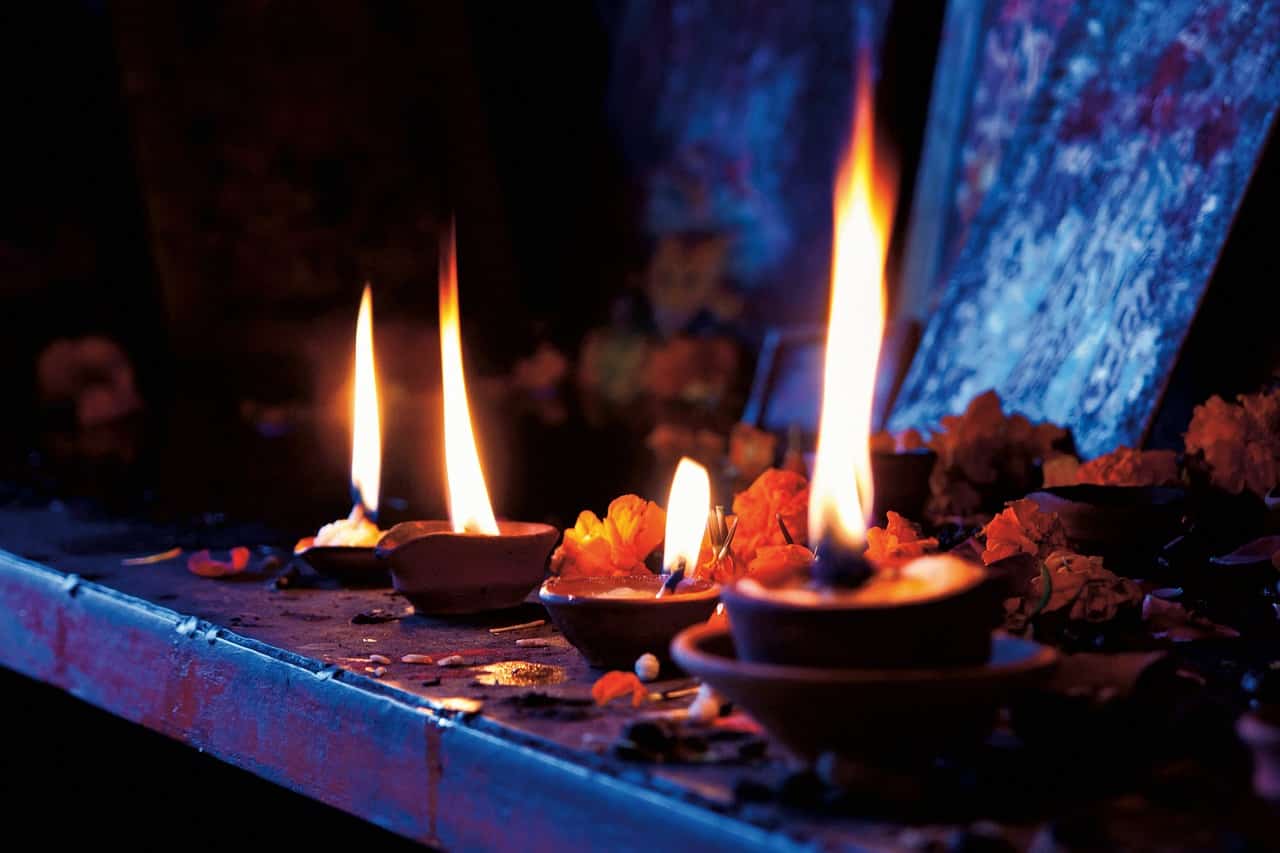
An altar is any structure on which spiritual/religious offerings, prayers, or rituals are made.
The root of the word altar means “high place” which reflects how symbolically sacred and important it is in spiritual practice.
Altars can be constructed of man-made or natural materials and they exist in almost every religion and culture.
In the spiritual, esoteric, and metaphysical sense, altars can be used for contemplation, ritual, prayer, reflection, lectio divina, gratitude, or any form of inner work.
Meditation altars can be small or large, fancy or minimalistic, traditional or non-traditional. The flavor, look and feel of your altar will depend on you and your own tastes and preferences.
Most importantly, it’s essential that your altar looks and feels authentic to your unique needs as you are the primary one engaging with it.
How to Build a Meditation Altar For Your Spiritual Practice
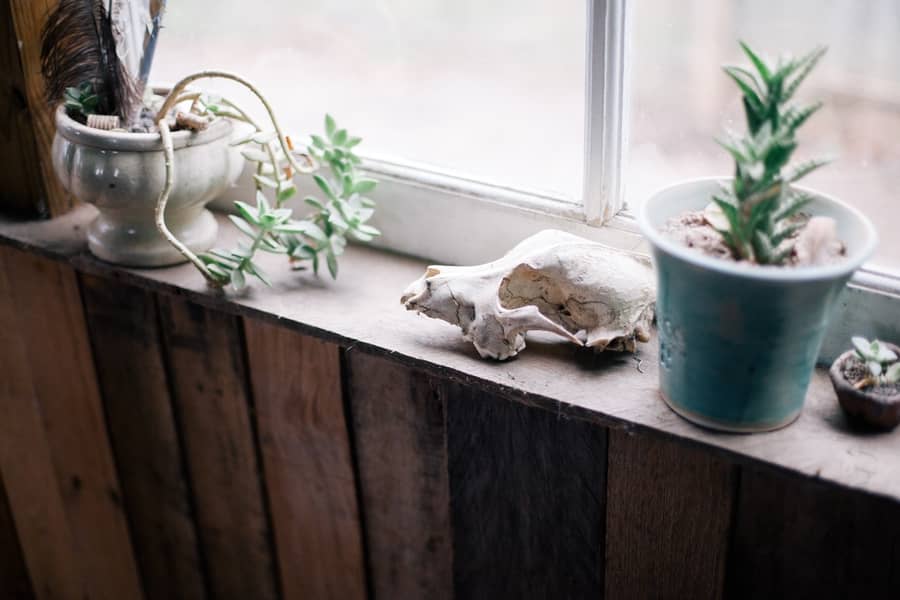
No matter what particular flavor or style of spirituality you’re attracted to, creating an altar will provide a powerful focal point for your energy.
Benefits of creating an altar include:
- Having a physical expression of your commitment, personal goal, or desire
- Having a symbolic collection/meeting place of tools to enhance your spiritual practice
- Enjoying a sacred space dedicated to your spirituality
- Making your deepest spiritual needs a physical and actualized part of your life
- Gaining a ‘spiritual center’ in your life that you can return back to each and every day
- Having a source of positive energy that fills your home
- Feeling a sense of empowerment through self-expression (i.e., building and maintaining an altar)
Whether you decide to build an altar for meditation, for religious belief, pagan practice or simply to further your inner work, here is a simple step-by-step guide:
Would you like to save this?
Your information will never be shared.
Step 1. Choose a place that looks or feels “right”
If you have a spare room, you might like to dedicate it to building a sacred altar. But not all of us have that luxury.
If you have very little space in your house, you might like to consider a corner or quiet place that will give you privacy.
I’ve seen beautiful altars in bedrooms, lounge rooms, offices, and even closets. When looking for a place, ask yourself the following questions:
– Does this place look appropriate?
– Does this place feel “right”?
– Do I have privacy here?
– Is this place quiet?
– Is the energy hurried, stressed, or heavy here?
– Can I build an altar here without disrupting or inconveniencing anyone else?
The ideal place in your house will be “out of the way,” quiet, and relaxed. It doesn’t need to be very large. In fact, due to space restrictions or simple preference you might like to build a “tiny” altar.
Tiny altars fit within the dimensions of a dinner plate. Some people even prefer to keep their altars portable in a jar! Do whatever feels the most comfortable for your needs and your current life context.
Step 2. Cleanse the space
The act of emptying and cleansing space has been practiced by shamans for thousands of years.
Why not follow in the steps of these shamans and cleanse any energetic debris from the room until it looks/feels “right” to you?
Make sure you hold the intent of, “I am cleansing this space” in your mind as you carry out this process. An energetically clean space will feel clear, light, and friendly.
To energetically cleanse the space, you could use sound (e.g., clapping your hands or using a singing bowl), scent (e.g., burning incense or herbs), light (e.g., lighting a candle or opening the windows and letting the sunshine in), visualization, or even simply dust and sweep the room.
If the surrounding space feels energetically ungrounded to you, you may like to use a drum or an earthy stone such as black tourmaline to ground the energy.
How do you know when the space is clean? You’ll notice that the area looks or feels cleaner, lighter, and more expansive (even if it’s just a small nook!).
Step 3. Begin to gather objects that are meaningful to you
When it comes to building an altar, there really are no rules. The practice is so personal, that the only key ingredient is to listen to your own heart and soul.
However, as a general guide, here are some things people tend to include on their altars:
– Objects that represent one’s spirit guides
– Objects that represent one’s primarily revered spiritual teacher
– Objects that reflect yin/yang, light/dark, masculine/feminine
– Objects that represent the body, mind, heart, soul, and spirit
– Objects that represent the elements of fire, water, earth, air, and aether
– Objects that represent qualities that one most wishes to embody (e.g., forgiveness, humility, love)
– Objects that represent one’s inner child or inner Guide
– Objects that represent the cycle of life, death, and transformation
– Objects that amplify energy (e.g., crystals, chimes)
– Any other objects that are inspiring, powerful, or helpful

Inner Work Journal Bundle:
Ready to take your spiritual practice to new depths? Our highly-rated set of guided inner work journals leads you step-by-step through processing trauma, transmuting pain into power, and finding transformation through deep healing and self-illumination.
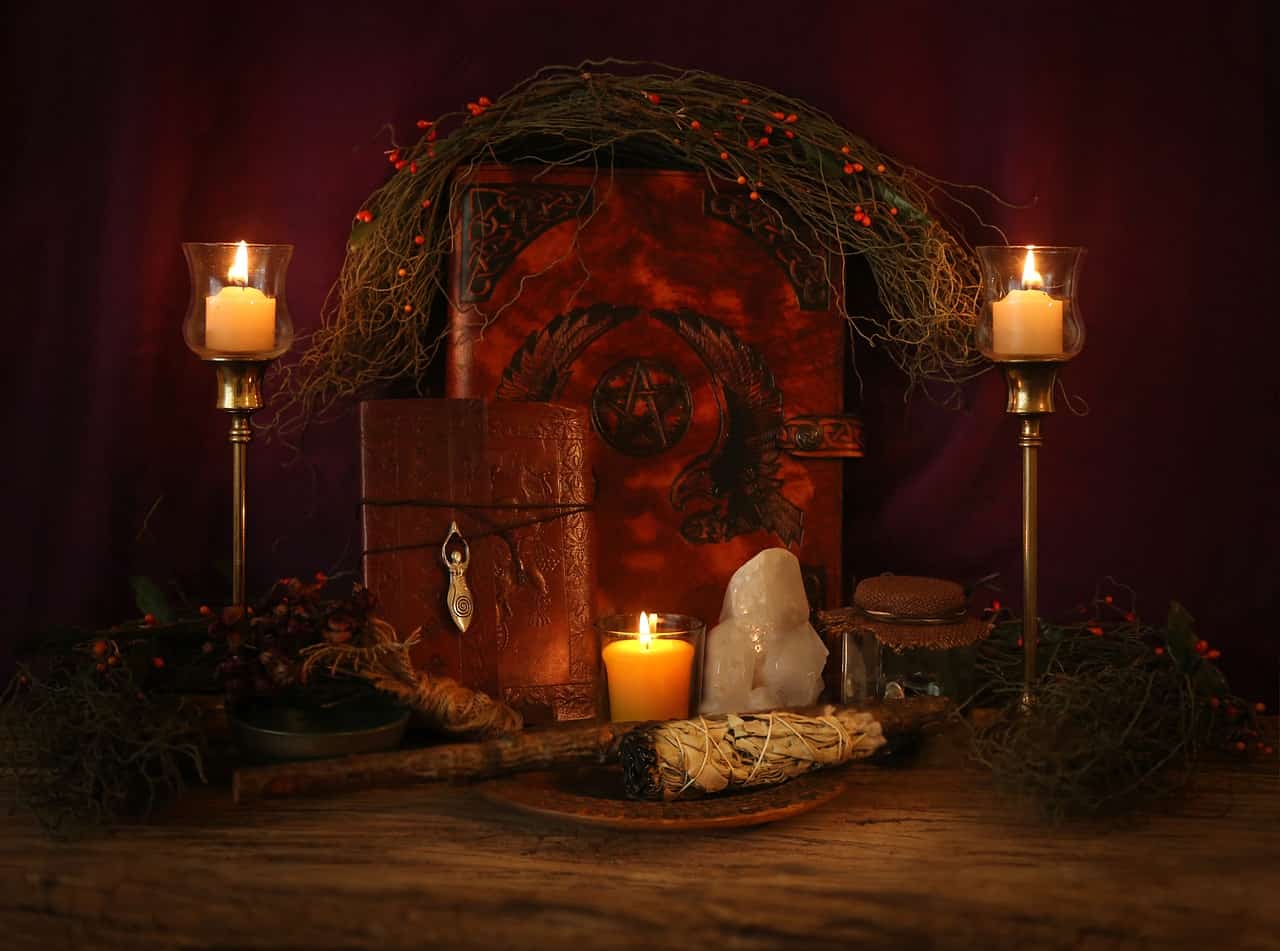
More specifically, objects you may wish to put on your altar could include:
– candles
– statues
– feathers
– stones
– crystals
– decorative stands
– inspiring quotes
– a journal
– written notes
– prayer books
– rosary beads
– skulls or bones
– alive plants
– water
– shells
– flower petals
– symbols
– sand
– salt
– photos
– oracle or tarot cards
– pebbles
– essential oils
Really, you can include anything on your meditation altar. Just make sure that you design it the way you would like it, not the way you think it “should” look. You can find some examples of altar objects in the appendix at the end of this article.
Also, be wary of cultural appropriation which is the practice of taking sacred objects (or rites) from indigenous cultures and using them in an unsanctioned way. It’s always important to pay our respects to members of other cultures. If you aren’t sure, opt for an alternative.
Step 4. Set an intention
When choosing objects for your sacred space, keep in mind the following questions:
– What will my meditation altar be used for and what is its purpose?
– What do I want to reflect or express through the altar?
– Does my altar have a theme?
These questions will help you to set a clear intention for your meditation altar, imbuing it with a deep felt sense of purpose.
Your answers to the questions above will also help you to decide what objects to choose.
Step 5. Arrange your altar
Once you’ve found your sacred space, have cleansed it, and have developed a clear intention (along with what types of objects to include), you’ll need to arrange your altar.
You’re free to arrange your altar in any way you wish, but ideally, try to arrange it in a symmetrical way.
Why is it best to arrange a meditation altar symmetrically? Symmetry reflects the energy of balance and wholeness — something you most certainly want to welcome into your sacred space! If your altar is cluttered and imbalanced, you might find it distracting or hard to work with.
Think of a mandala: the left and right sides are both harmonious mirror images of each other. While your altar doesn’t need to be this precise, you can use the image of a mandala to help you out.
Depending on your intention, your meditation altar may also benefit from having a central piece or focal point.
The focal point of your altar is located right in the middle and it’s a place where your eyes most comfortably settle. Your focal point could be anything: a statue of a beloved deity or spirit animal, a vase of fresh flowers, a photo of a loved one, or even a large burning candle. It’s up to you!
Step 6. Maintain your altar
It’s crucial to keep your meditation altar clean from cobwebs, dust, and other residue – it shows respect for your practice. After all, this area is supposed to be your hallowed space!
Clean your meditation altar as regularly as you feel necessary (once every one or two weeks is a good habit).
Finally, remember that your altar doesn’t always need to stay the same! You’re free to change, adjust, add to, or take away from it whenever you choose.
As your spiritual practice develops, you might find that certain items on your meditation altar are no longer relevant or necessary. In the same manner, you may begin to feel like something is “lacking” from your altar and so you’ll need to adjust it likewise.
Above all, allow your altar to be a holy physical place in which you can sit quietly, reflect, be still, commune with your Soul, thank your guides, show gratitude, and reconnect with the Divine. Your sacred space is yours to build, adjust, nourish, and cherish every day. It’s one of the most precious gifts you can give to yourself!
Meditation Altars and the Value of Minimalism
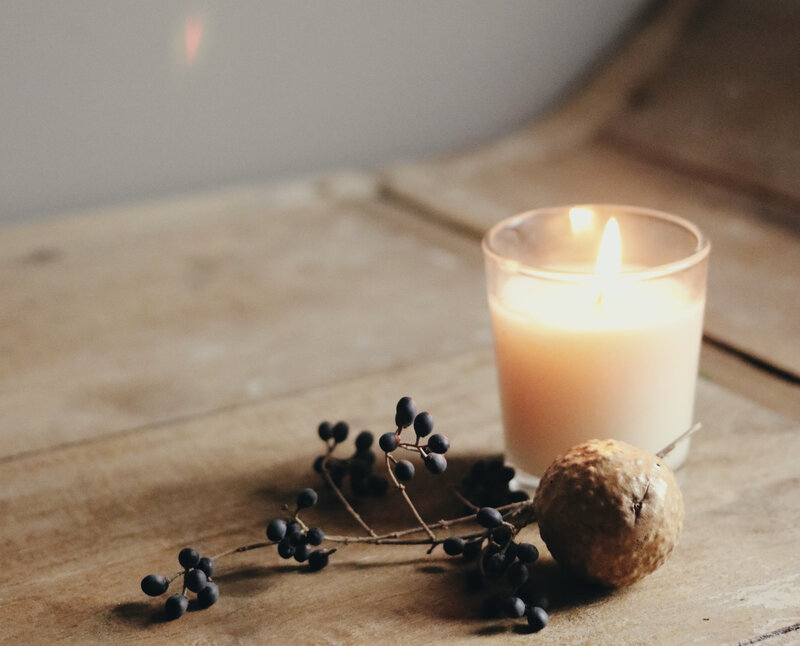
There’s a fine line between nurturing and consecrating a special space and going down the rabbit hole of spiritual materialism.
Remember that you don’t need to purchase lots of trinkets or social-media-pretty items. In fact, doing so can take away from the deeper intention and purpose of this space.
Minimalism – or the philosophy of “less is more” – helps to add the element of aether to your meditation altar. Without space, without aether, our focus can become dulled and our senses overwhelmed.
Remember, your meditation altar is your spiritual workplace; your physical space of power. And to access the inner realm, we need quietude. We don’t want clutter or too much complexity if it’s unwarranted.
As such, you don’t need to spend a lot of money to create an altar that is significant to you – look around your own home, in the natural world around you, or in a local thrift store to find special and meaningful objects.
Often a simple candle and photo is more powerful that tons of pretty, but ineffectual, objects gathered together.
Appendix – Altar Tools & Materials

Your meditation altar is a sacred space; an outward expression of your inner feelings, thoughts, and beliefs.
If you’re struggling with ideas, you can find some inspiration below.
Please note that creating an altar is a deeply personal and significant process. You don’t actually need to purchase anything. You don’t need even need to make it fancy. This space is completely yours to build.
The links below are simply ideas and examples to help your process*:
Candles: pillar, tealight, votives
Statues: pagan, religious, animal
Crystals: quartz, moonstone, labradorite, carnelian, amethyst, selenite, citrine, black tourmaline
Altar Table: tree of life, meditation, rustic
Incense: frankincense and myrrh, sustainable palo santo, sandalwood, assorted
Essential Oil: lavender, rose, peppermint, assorted organic oils
Oracle Cards: shamanic, angel, sacred geometry, shadow work, goddess
Miscellaneous: journal, altar cloth, plants, essential oil diffuser, incense holder, singing bowl, candle holders
Conclusion (+ My Altar)
Here is a picture of my current meditation altar (I change it periodically):
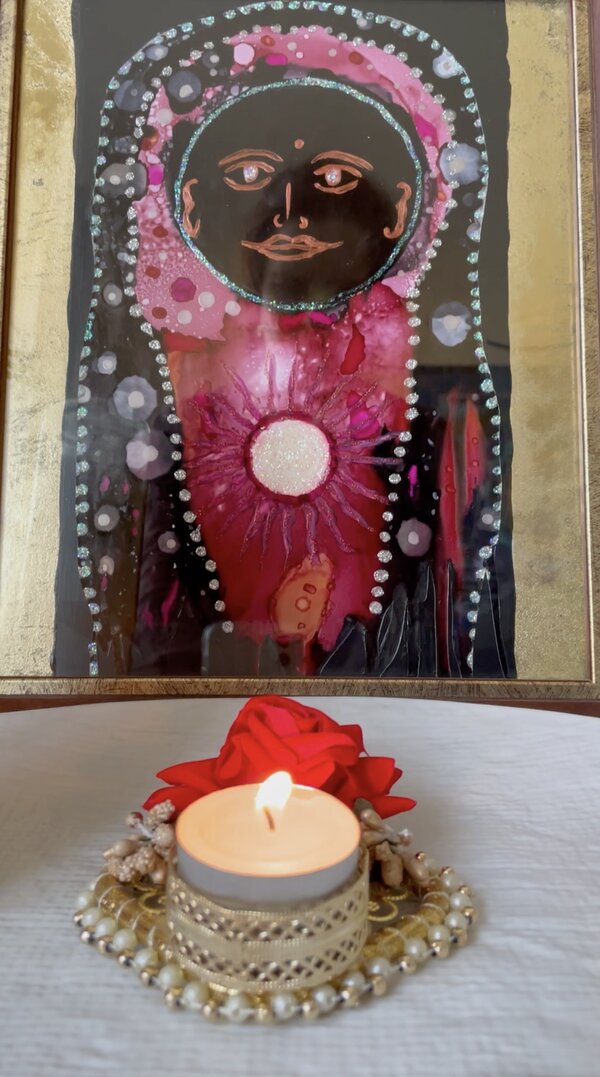
As you can see, this is an extremely minimalistic altar. There’s a candle and a painting (that I painted myself) of the Black Madonna – an ancient figure that helps me to reconnect with my heart. And that’s it!
As you can see, there’s nothing overly expensive or fancy on my meditation altar. Again, you don’t need to break the bank to create a beautiful sacred space. Many items you can simply thrift or gather from your house/natural surroundings.
To close this article, I want to reiterate again that your meditation altar is unique to you. We can easily feel pressured to “show off” or create Instagram-worthy spaces – but that totally misses the point!
What’s most important is the energy and intention you imbue into your sacred space. That’s all that ultimately matters.
Do you have a meditation altar? If so, I’d love to read about your process and what role this space plays in your life. Let’s share some inspiring ideas to motivate each other!
*Please note that this article has affiliate links. If you decide to purchase anything we link to, we get a small percentage to help with our work. Thank you!
Three paths to inner transformation – here’s how I can help you go deeper:
1. The Spiritual Wanderer Course: Are you feeling lost, adrift, and unsure of your life's purpose? Gain clarity, focus, and direction on your inner path by uncovering the five archetypes of awakening within you. Learn how to navigate the highs and lows of your inner journey and chart your unique path with 3+ hours of audio-visual content, workbooks, meditations, and a premium test.
2. Shadow & Light Membership: Do you crave consistent support on your spiritual quest? Receive weekly intuitive guidance and learn to embrace your whole self, including your shadow side. Cultivate deeper self-love with our affordable, personalized support.
3. Spiritual Awakening Bundle: Ready to embark on a profound soul-searching adventure? Dive into our collection of essential transformative resources! Explore five illuminating eBooks and seven in-depth journals, plus unlock two special bonuses to empower your spiritual growth.








Personally, I don’t feel the need for an altar, or at least a physical one, though I’d like to keep certain ideas in mind within when it comes to my sense of spirituality. Though in speaking around my idea of spirituality, I suggest looking up the Joe vs Elan school comic online, in the website elan.school, which is a real story from someone who survived a very abusive school meant to teach certain ideas of morality, by putting forward very extreme punishments to “teach people a lesson.” While I warn it may be too graphic to some, observe the tactics and punishments Elan school gave to Joe that may seem similar to your experience in real life, even if not in an academic environment.
That is, things like being told that you have to act the same as everyone else or you will be punished. That you cannot express yourself individually in any way that looks different from others, or you will be punished. That you have to put all your time and effort to certain moral ideas, while ignoring your interests, hobbies, and passions because such things are a “waste of time.” I could reference all kinds of other abusive groups out there, but this seems to be the least graphic and most approachable example I can think of while still being shocking enough to tell people something. Or at least, that’s where my intuition goes to as a message to the people on this website.
Perhaps less visual examples would be less graphic to the viewer, if this is too much for someone. Then look up “Podcasts about cults,” if you want to learn some examples without any images included, or if you do view the images of these types of things, but you want a break from it sometimes. I won’t name specific podcasts here, but if you look up the terms, “Podcasts about cults,” “Podcasts about deconstruction,” and “Podcasts about fundamentalism.” Also, feel free to pick any spiritual/religious book you like, and look up reviews on the book on websites such as Goodreads, YouTube, Amazon, or any other place with reviews. Make sure to read both the positive and negative reviews for a balanced viewpoint, even if you have a bias towards liking it or disliking it, and especially pay attention to those that have the opposite opinion or someone who rates a book as average, because often the 3/5 or 5/10 type reviews seem to offer the most balanced ideas.
Thank you for the really clear informative post! It was really helpful to me when I build my altar. I wrote about it (and credited you of course):
https:// hawkandhandsawjewelry.com/altared-intentions/
I’ve got to wonder Luna, what is your process of writing an article here (like this one)?
Does it take you long to finish it? Does it take a lot of work?
i correspond with you
Thank you for your inspiration and knowledge. I am still learning about all things spiritual etc(Raised Catholic), i am excited to make myself an altar.
This is wonderful Luna. I said to my sister last weekend that I wanted to create a little space for meditation, and place my stones, incense and small candles that a friend gave me for mindful moments. Just a few days later you published this article. I shared it with my sister repeating to her that the universe gives you what you want if only you ask for it. Thank you for this, again you have given me what I needed, exactly when I needed it xxx
Divine synchronicity in action!
xo
Thank you for inspiring me to create my conscious alter…I’m going to look around my home and choose items that feel good to include.
Great work
Lesley
That will be a fun process! :)
Early this year I had a spiritual awakening which made me unconsciously rearrange my entire home. I didn’t realise it at the time but I actually put together an alter in my bedroom, which finally had a space for all the stones, feathers, sand, dried flowers, paintings I had collected over the years. It was a magical ‘ah-ha’ moment when I started diving deeper into spiritually and realised that I had already incorporated so much into my own practice. I completely agree in keeping it authentic and not spending $$$ – I have started spending a lot more time in nature and the universe gifts me with crystals and other little surprises every now and then :)
Reading your comment makes me think that our entire homes (yes, and our lives too) can be altars: spaces for sacredness. Thank you for inspiring this thought, Alisha!
When we were both with the Anglo Catholics here in Brisbane, we had a home alter comprising of one white linen table cloth laid over an old metal-framed small table about waist height. The central section had a small piece of table lace which fitted nicely, with two small candle holders and basic household candles on either side. A small silver cross in the central section with small statues of Mary and Jesus on either side then photos in little stands for any favorite Saints of Eastern or Western cultures. Additional things like a rosary or small icons, gifts, and prayer cards were used in a migratory sense as they would come to the alter, then be given in a heartfelt way to anyone, neighbor, friend, or acquaintance that turned up for prayers, Morning or Afternoon religious meetings or just those in need of an inner boost.
Careful not to ingratiate our Spiritual views on anyone in case their cultural and religious sensitivities were held in slightly different modes. Or not at all in some cases!
So our home alter was both a spot for quiet reflection when things were not busy.
Plus a small balanced table reflecting our belief systems of that time and place which held convey and include others in our style of spirituality.
Now it’s a small narrow book shelve of treasured books and one candle and holder and one nice image of Jesus upon the opposite wall, next to my meditation chair. As I often reflect on psalms and readings as well as meditation. But am happy with other approaches too from Tibetan and Indian cultures too. As Spiritualism has opened many new avenues and ways of seeing and practicing inner feelings and contemplation after Christian ways. Both live in harmony in our little house.
Namaste…John
Beautiful! I love the integration of different expressions of faith. That is one of the powers of altars: they help to unite different threads, feelings, thoughts, longings, and beliefs. They remind us that All is One in the symbolic form of single space. Thanks for sharing your experience John!
Loved the article. I made an altar that contains items that resonated with me as I added to it. I never heard to do it symmetrically though. I built mine to house the things I love and mean something to me. I put mine in my bedroom because it is where I meditate. Because of my arthritis in my entire back and knees I am unable to sit crossed legged on the floor. It’s a conglomerate and that’s how I feel personally. I am not just one thing spiritually. So I would say my not symmetrical altar matches it’s not symmetrical human.
Absolutely Crystal, you do you. ;) The tip I gave about symmetry works for me which is why I recommended it, but meditation altars are extremely unique to each person, which is why it’s best to tune into what resonates the deepest with you. Thank you for reading!